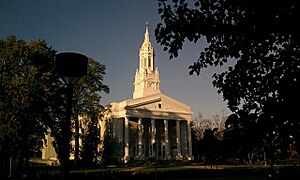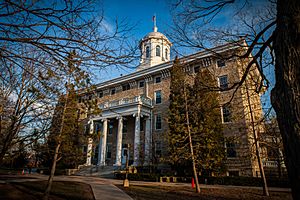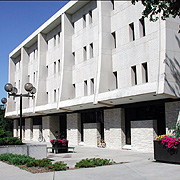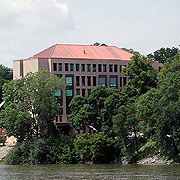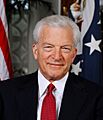Lawrence University facts for kids
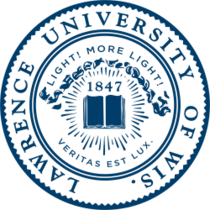 |
|
|
Former names
|
|
|---|---|
| Motto | Light! More Light! Veritas est lux. |
|
Motto in English
|
"Truth is Light" |
| Type | Private liberal arts college |
| Established | 1847 |
|
Academic affiliations
|
|
| Endowment | $440 million (2022) |
| President | Laurie Carter |
| Students | 1,465 (fall 2023) |
| Location |
,
,
United States
44°15′40″N 88°24′00″W / 44.261°N 88.400°W |
| Campus | Urban: 84 acres (34 ha) Björklunden: 425 acres (172 ha) |
| Nickname | Vikings |
|
Sporting affiliations
|
NCAA Division III – Midwest Conference |
 |
|
Lawrence University is a private college and music school located in Appleton, Wisconsin, United States. It's known for its focus on liberal arts (a broad education in many subjects) and its special music program. The university was founded in 1847, and its first classes began on November 12, 1849. Lawrence was one of the very first colleges in the U.S. to welcome both male and female students, which is called being coeducational.
Contents
History of Lawrence University
Lawrence University was started by William Harkness Sampson and Henry R. Colman. They used $10,000 given by a generous person named Amos Adams Lawrence. The Methodist church also matched this amount.
The school was first called the Lawrence Institute of Wisconsin in 1847. But before classes even started in 1849, its name was changed to Lawrence University. The oldest building still standing on campus, Main Hall, was built in 1853.
The college grew a lot when Samuel G. Plantz was president from 1894 to 1924. During this time, the number of students grew from 200 to 800.
From 1913 to 1964, the school was known as Lawrence College. This name was used to show that it was a smaller school focused on a wide range of subjects. The name changed back to Lawrence University when it joined with Milwaukee-Downer College. Even today, degrees are given "on the recommendation of the Faculty of Lawrence and Downer Colleges."
The Conservatory of Music
The Lawrence Conservatory of Music, often called "the Con," started in 1874. It's a special part of the university where students can study music in depth. Students can earn different music degrees, including a Bachelor of Music. There's also a five-year program where students can get both a Bachelor of Arts and a Bachelor of Music degree.
First-Year Studies Program
All new students at Lawrence take a required two-term class called First-Year Studies. In this class, students read and discuss 11 important works of literature, art, and music. The list of works changes each year. This program began in 1945 and helps all students share a common learning experience.
Past Presidents
Lawrence University has had many leaders throughout its history. Here are some of the people who have served as president:
- 1849–1853 William Harkness Sampson
- 1853–1859 Edward Cooke
- 1859–1865 Russell Zelotes Mason
- 1865–1879 George McKendree Steele
- 1879–1889 Elias DeWitt Huntley
- 1883–1889 Bradford Paul Raymond
- 1889–1893 Charles Wesley Gallagher
- 1893–1894 L. Wesley Underwood (acting president)
- 1894–1924 Samuel G. Plantz
- 1925–1937 Henry Merritt Wriston
- 1937–1943 Thomas Nichols Barrows
- 1944–1953 Nathan Marsh Pusey
- 1954–1963 Douglas Maitland Knight
- 1963–1969 Curtis William Tarr
- 1969–1979 Thomas S. Smith
- 1979–2004 Richard Warch
- 2004–2013 Jill Beck
- 2013–2021 Mark Burstein
- 2021–present Laurie Carter
Campus Life and Facilities
The main campus of Lawrence University is about 84 acres and is located in downtown Appleton. The Fox River divides the campus into two parts. The academic buildings are on the north side of the river. The main sports facilities, including the Banta Bowl, are on the southeast side.
Lawrence also has a large 425-acre property called Björklunden in Door County, Wisconsin. This beautiful northern estate is used for special events like retreats, seminars, concerts, and plays. It also has a chapel.
In 2009, Lawrence opened the Richard and Margot Warch Campus Center. This building is a central spot for students, teachers, staff, and visitors. It has a cinema, dining services, mailboxes, and many spaces for meetings and events. The building is designed to be environmentally friendly.
Academics and Learning
Lawrence University has a small student-to-teacher ratio, which means there are about 9 students for every teacher. This allows for more personal attention and discussion in classes.
The college offers many different majors in the liberal arts. Students can also create their own unique majors or combine different areas of study. Lawrence gives out Bachelor of Arts and Bachelor of Music degrees, and it's possible to earn both. The school also has programs that help students prepare for careers in fields like engineering and health sciences.
The Lawrence University Conservatory of Music is a big part of the university. About 25% of all Lawrence students are part of the Conservatory. They can study performance, music theory, music education, and more. The Conservatory has many musical groups, including choirs, bands, jazz ensembles, and a symphony orchestra.
Lawrence is part of the Associated Colleges of the Midwest, which is a group of 14 colleges that work together. This group helps students find study-abroad programs in many different countries. Lawrence is also part of the Oberlin Group, which connects liberal arts college libraries.
Rankings and Reputation
Lawrence University is recognized as a strong liberal arts college. In the 2025 U.S. News & World Report rankings, it was tied for 69th among 211 liberal arts colleges in the country.
Student Life and Traditions
Lawrence University has about 1,500 students. Many students come from different countries, and about a quarter of them study in the Conservatory of Music.
Lawrence students have won many important scholarships, like the Rhodes Scholarship and Fulbright Scholarships. These awards help students study or do research around the world.
Fun Traditions
- Welcome Week: Every September, new students arrive a week early for Welcome Week. They do fun activities to get to know each other and college life. A special tradition is the "matriculation handshake," where each new student shakes hands with the university president.
- Beach Bash: In the fall, a student group called Beta Theta Pi hosts the annual Beach Bash. They bring tons of sand into their house basement to create an indoor beach party!
- LU-aroo: In the spring, Lawrence has its own music festival called LU-aroo (like the famous Bonnaroo festival). It takes place on the campus quad and features talented student bands.
- The Viking Room: There's a popular lounge on campus called the Viking Room (VR). Teachers often serve as guest bartenders, and students who are old enough to drink can get their own special numbered mug to use there.
Campus Media
The student newspaper, The Lawrentian, has been published for over 100 years. It keeps students updated on campus news and events.
Athletics
| Lawrence Vikings | |
|---|---|
 |
|
| University | Lawrence University |
| Conference | Midwest Conference Northern Collegiate Hockey Association (hockey only) |
| NCAA | Division III |
| Athletic director | Jason Imperati |
| Location | Appleton, Wisconsin |
| Varsity teams | 21 |
| Football stadium | Banta Bowl (5,255) |
| Basketball arena | Alexander Gymnasium |
| Baseball stadium | Whiting Field |
| Mascot | Blu the antelope |
| Nickname | Vikings (1926) |
| Fight song | "Go, Lawrence, Go" |
| Colors | Navy and White |
Lawrence University's sports teams are called the Vikings, a name they've used since 1926. They compete in National Collegiate Athletic Association (NCAA) Division III. This means they focus on academics as much as sports.
Lawrence offers many sports for both men and women, including:
- Men's sports: baseball, basketball, cross country, fencing, football, golf, ice hockey, soccer, swimming & diving, tennis, and track & field.
- Women's sports: basketball, cross country, fencing, golf, soccer, softball, swimming & diving, tennis, track & field, and volleyball.
The men's basketball team has been very successful. In the 2005–06 season, they were ranked first in Division III for a long time and finished with an amazing record of 25 wins and only 1 loss. They also made it to the national tournament several times.
In 2021, Lawrence introduced a new sports logo featuring a Viking ship with an antelope. In 2022, they also got a new mascot named Blu, who is an antelope.
Notable People from Lawrence
Notable Faculty
- William Chaney, historian
- Richard N. Current, historian
- Estelí Gomez, soprano
- William H. Riker, political scientist
- Charles B. Schudson, judge
- Fred Sturm, jazz composer and musician
- Arthur Thrall, artist
- John Holiday, opera singer, music professor
- Peter N. Peregrine, anthropologist and archaeologist
Notable Alumni
-
Thomas A. Steitz
(B.A. '62)
Nobel Prize-winning biochemist
- Jennifer Baumgardner, 1992, writer and activist
- Bonnie Bryant, 1968, author of children's books
- Louis B. Butler Jr., 1973, former justice of the Wisconsin Supreme Court
- Susan M. Crawford, 1987, justice-elect of the Wisconsin Supreme Court
- William Diver, 1942, linguist
- Pawo Choyning Dorji, 2006, filmmaker and photographer
- Dale Duesing, 1967, opera singer
- Edna Ferber, author and playwright (attended)
- William Fuller, 1975, poet
- Dominic Fumusa, 1991, actor
- Walter Samuel Goodland, former governor of Wisconsin (attended)
- Earnest Hooton, 1903, physical anthropologist
- Bruce Iglauer, founder of Alligator Records
- Lester Johnson, former Congressman from Wisconsin
- Zachary Scot Johnson, 2001, singer-songwriter
- Scott Klug, 1975, former congressman from Wisconsin
- Peter Kolkay, bassoonist
- Barbara Lawton, 1987, former Lieutenant Governor of Wisconsin
- Fred Lerdahl, 1965, composer and music theorist
- John A. Luke Jr., 1971, CEO of MeadWestvaco
- Harry N. MacLean, 1964, true crime author
- Momodu Maligie, 2004, Minister of Water Resources for Sierra Leone
- James Merrell, 1975, professor of history
- Terry Moran, 1982, journalist
- David Mulford, 1969, former United States Ambassador to India
- Tom Neff, 1975, CEO and founder of The Documentary Channel
- Garth Neustadter, 2011 Emmy winner for music composition
- Jessica Nelson North, 1917, author
- Alice Peacock, 1992, singer-songwriter
- Cindy Regal, 2001, experimental physicist
- Eben Eugene Rexford, author on gardening (attended)
- Josh Sawyer, video game designer
- Campbell Scott, 1983, actor
- Michael Shurtleff, 1942, casting director, author
- Eric Simonson, 1982, Oscar-winning writer–director
- Red Smith, 1926, MLB and NFL player
- Anil Singh (judge), 1980, associate justice of the New York Supreme Court, Appellate Division
- Janet Steiger, 1961, former chairman of the Federal Trade Commission
- Thomas A. Steitz, 1962, Nobel Prize winner in Chemistry
- Heidi Stober, 2000, opera singer
- Fred Sturm, 1973, jazz composer and arranger
- Anton R. Valukas, 1965, U.S. attorney, author
- Madhuri Vijay, 2009, novelist
- William Warner, U.S. Senator from Missouri (attended)
- Tom Zoellner, 1991, author, journalist
See also
- List of NCAA fencing schools


